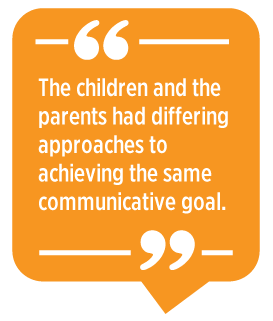|
 In today’s globalized world, transnational living patterns
are commonplace. Mobile, transnational families have living arrangements spread
over two or more countries while maintaining the language skills for
multinational communication (Hirsch & Lee, 2018). The children of
transnational families develop multilingual literacies in which they use
diverse linguistic resources and modalities.
In today’s globalized world, transnational living patterns
are commonplace. Mobile, transnational families have living arrangements spread
over two or more countries while maintaining the language skills for
multinational communication (Hirsch & Lee, 2018). The children of
transnational families develop multilingual literacies in which they use
diverse linguistic resources and modalities.
We, the
authors, identify as multilingual researchers who are part of a transnational
family. Magdalena was born and raised in Poland, lived more than 14 years as an
adult in a Spanish-speaking country, and has resided in the United States for
almost 5 years. Her professional socialization for almost 20 years has been in
English. Jason was born and raised in the United States; he has lived more than
10 years outside of the United States (namely, in Ecuador, Germany, and the
United Arab Emirates) and considers himself fluent in German with emergent
Polish and Spanish. Other family members of the immediate household include
Magdalena’s teenaged daughter and preteen son. We promote translingual
practices in the home, a practice that generates unique opportunities for the
children’s linguistic and communicative development.
 Familylect Familylect
In this
article, we focus on the concept of familylect
(Søndergaard, 1991)—that is, the familial idiosyncrasies that distinguish a family’s
members from other equally proficient speakers. The field of Family Language
Policy studies encourages parents, teachers, and social workers to support the
maintenance of multilingual familylects. Family Language Policy work includes a
range of familial relations, including transnational and nontraditional
families, such as remarried, single, LGBTQ, and foster configurations, among
others.
The
following descriptions demonstrate how children use their multilingual
resources within the familylect to express agency, or, more specifically, how
these participants negotiate and take ownership of the narrative in which they
are engaged. The situations originate from the recording of an afternoon
session of family games intended to encourage translingual practices.
Expressing Agency Through
Games
The session
consisted of a set of four specially designed communicative games, the last of
which was a collaborative oral story with self-sourced objects. In this game,
each participant (the two authors as well as May, 14 years, and Jim, 11 years)
brought three different self-sourced objects to the table, then subsequently
took turns incorporating their objects into the collaborative story. In delayed
interviews (approximately 18 months), all participants expressed enjoying this
activity the most.
During the
game, the children expressed agency in several ways.
Language
Choice
One of the
first expressions of agency was language choice. For example, family members
expressed the items they had brought to the table in the language of their
choice, as follows:
|
Player |
Item Brought |
Choice of
Expression |
Language |
|
Magdalena |
scissors |
nożyczki |
Polish |
|
umbrella |
parasol |
Polish |
|
Easter
egg |
pisanka |
Polish |
|
Jason |
nail
clipper |
nail
clipper |
English |
|
hair
band |
hair
band |
English |
|
coaster |
coaster |
English |
|
May
(14) |
bottle of
water |
water |
English |
|
lighter |
encendedor |
Spanish |
|
jam |
marmelada |
Spanish |
|
Jim (11) |
honey |
honey |
English |
|
salt |
salt |
English |
|
a
strawberry |
Señor Fresa* |
Spanish |
*
Señor Fresa translates to “Mr. Strawberry,” a familylect nickname
for Jason.
In addition
to the agency of language choice, Jim also expressed agency through the
familylect term Señor Fresa by (1) indirectly challenging
the guidelines that required everyone to bring an object to the table, and (2)
maintaining the use of Señor Fresa even after his mother
corrected him several times with fresa (withoutSeñor).
Negotiation
Another
example of agency occurred when the eldest child, May, took the initiative to
introduce a new idea and change the form of the narrative from ordered to
random. She seemed initially uncertain, seeking her mother’s approval by
looking at her while explaining her suggested revisions to the rules. May
argued that this innovation would increase players’ attention and create more
dynamic interactions; she gave an example of how the narrative would unfold and
explained the rules for choosing the next storyteller. She concluded with a
direct question regarding her mother’s approval; Jason and Jim accommodated
Magdalena’s positive uptake of the suggestion to change the narrative’s
modality.
Through
May’s agency, the direction of the game and the ensuing activities were
altered, and the parents supported the suggestions. Though this event did not
noticeably employ multilingual resources, the multilingual game time opened a
space for negotiating a co-constructed translingual activity.
Storytelling
The
storytelling process itself was another opportunity for expressing agency. The
collaborative turn-taking allowed for the incorporation of body language,
meaning-making, and the expression of affect. Jim was a creatively agentive
narrator. As was later discovered, he not only created an alternative storyline
by interacting with the camera throughout the recording, but he also assumed
opportunity to define both the protagonist and antagonist of the narrative. In
naming the antagonist, he transformed a minor character who had been introduced
into the narrative by his sister into a vile adversary, and through his agency
of simultaneous, wordless interaction with the camera, he constructed a
secondary storyline. Though expression of this agency would not be possible
without participant awareness of the camera, it nevertheless influenced post
hoc interpretations of the storyline and events of the game.

Communicative Context
The
recording demonstrates the children’s comprehension of and participation in the
various parts of the story narrated in English, Polish, and Spanish. Though
they primarily used Spanish between them, the majority of their contributions
were in English because, as they stated in the delayed interviews, they wanted
to accommodate Jason’s emergent Spanish and Polish. In this way, the children
demonstrated awareness of the communicative context and expressed agency
through their linguistic choices. Magdalena and Jason, on the other hand,
expressed agency by choosing to scaffold their contributions through
conscientious speech and body language. The children and the parents had
differing approaches to achieving the same communicative goal.
Familylect and Translingual
Practices
The
children’s agency can be summarized in terms of accommodating other speakers,
proposing new rules, (re)shaping the storyline, and creating alternative
storylines. Our family’s familylect demonstrates translingual practices and
indexical cultural and social cues for objects and people; it inspired
storylines and influenced lexical choices throughout the narrative. This
familylect is both unique and time-constrained; during the delayed interviews,
we realized that we have new indexicalities. For example, though English,
Polish, and Spanish still compose the base of our translanguaging, Jim recently
started to learn German; he frequently seeks to incorporate that language into
interactions with Jason, and Señor Fresa has become less
of a presence as new nicknames have replaced the old. Nevertheless, the
situations described here demonstrate how a familylect augments family bonds
(Van Mensel, 2018).
As parents
who are both language pedagogues and researchers, we are perhaps more
conscientious of creating and encouraging spaces for translingual practice than
many other parents. We may be more able to recognize how translingual family
games can foster children’s agency in the development of transnational
identities, strengthen intrafamilial relations, and position the uniqueness of
our familylect as a source of pride. Transnational and multilingual families
should understand the benefits of translingual practices, and educational
professionals should encourage and support translingual practices among such
families.
Other Games for
Translanguaging
Translingual
games can take numerous forms beyond the storytelling format of the game described
here; indeed, with little modification, even popular card and boardgames can be
a catalyst for translingual interaction. For example:
-
The rules of Scrabble could be adapted to allow for translanguaging
when the components of the familylect have overlapping alphabets.
-
Games such as Uno, Scattergories, or charades can be easily adapted to
encourage flexible usage of players’ translingual resources.
-
MadLibs
texts may be completed in any language players choose.
Games can
provide a break from established familylect patterns, promote creativity, and
develop child agency in Family Language Policy. Pedagogues can encourage
transnational parents to utilize the entirety of their linguistic repertoires
through family games. Family Language Policy can and should inform regional or
national policy makers and, consequently, social workers in appreciating
translingual practices of families who express their transnational identity
through their familylects.
References
Hirsch, T.,
& Lee, J. S. (2018). Understanding the complexities of transnational
family language policy. Journal of multilingual and multicultural
development, 39(10), 882–894.
Søndergaard,
B. (1991). Switching between seven codes within one family—a linguistic
resource. Journal of multilingual and multicultural development,
12(1-2), 85–92.
Van Mensel,
L. (2018). 'Quiere Koffie?' The multilingual familylect of transcultural
families. International journal of multilingualism, 15(3),
233–248.
Magdalena
Madany-Saa has been an English teacher
educator for more than 25 years. She worked in Ecuador training in-service
teachers between 2004 and 2016. Nowadays she is based in State College,
Pennsylvania, USA. She is a PhD candidate and TESL instructor in the College of
Education at the Pennsylvania State University. Magdalena’s research interests
are language policy, translanguaging, and decolonial
pedagogy.
Jason
Litzenberg is director of the Intensive
English Communication Program and associate teaching professor of applied
linguistics at The Pennsylvania State University. He is fluent in English and
German, with basic knowledge of Polish and Spanish. His research interests are
program administration, language policy, linguistic landscape, and English as a
lingua franca. |